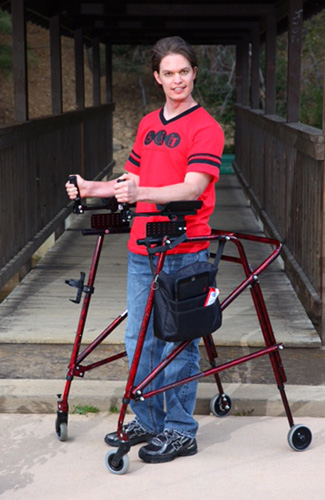Jenny Carter’s son Sean was involved in a motor vehicle crash in Wichita Falls, Texas, during the small hours of Sunday, March 27, 2005. He was the passenger in a truck, driven by a college friend who was drunk. Here, Jenny tells Three60 about how life changed in that moment for Sean, herself and the rest of the family.
Jenny, what was life like before Easter Weekend 2005?
I was a single mother and empty nester. All three of my sons were grown, living lives of their own. I had completed a Marathon, walking 26.2 miles in December of 2004, and was training to participate in the New York City Marathon in 2005. I had already been selected in the lottery that you have to enter to be a participant. I was working full time for a group of 4,700 emergency room physicians, and traveled around the U.S. as one of their Regional Billing Coordinators. I had Platinum flight status, racking up significant air miles for work. I loved my job, and enjoyed my life.
Sean was attending college in Wichita Falls, Texas at Midwestern State University. He was working and attending college full-time. He didn’t make a lot of money, but was totally responsible for all of his expenses. He had goals, and planned on obtaining his Bachelor’s degree and then wanted to go on to Law School.

What happened in the early hours of Sunday March 27, 2005?
This is what we have pieced together: Sean went out drinking with a couple of buddies that Saturday night before Easter Sunday. They had gone to a couple of bars. All three of them were drinking. We know from the toxicology reports that Sean was considered legally drunk. We also know that the driver was even more drunk than Sean was.
On the way home, probably not five minutes from Sean’s apartment, the driver lost control of his Dodge Ram pickup truck and it spun and slammed into a tree right where Sean was sitting. Sean was seat-belted in and the two guys (the driver and the other passenger) were sitting beside him on the truck’s bench seat. When the truck hit the tree, Sean’s body was unable to move in to the left, and his entire right side shattered. He had a fractured femur, the neck of his femur was shattered, as was his pelvis. His right arm, the humerus, was fractured. His bladder was ruptured, and his liver and spleen were lacerated. His right lung was collapsed. The combination of these injuries was life threatening, but worst of all was the fact that he was totally non-responsive.
He was taken to the emergency room at United Regional Hospital in Wichita Falls as a Glasgow Coma Scale 3. After being stabilized there, he was transported by ground ambulance to Parkland Hospital in Dallas, a Level 1 Trauma Center. That is where it was confirmed that he had also sustained a traumatic brain injury. Sean’s head never hit anything, and nothing hit his head. The velocity of his head as it was thrown from side to side when the truck slammed into the tree and abruptly stopped, caused an all-over brain injury called a diffuse axonal injury. The young neurosurgeon who explained it to me said that it was classified as “Severe”.
When I had an opportunity, I went to a computer and did some research and read that 90% of people diagnosed with a severe diffuse axonal injury never emerge from coma. The other 10% who do emerge are frequently so impaired cognitively that they are unable to function on their own in society.
What was the outlook for Sean following the collision?
As Sean lay in coma for 39 days, the experts could only tell me that “We just don’t know” how he will be. When he began to emerge from coma we realized that Sean could do nothing, not even speak or swallow. He could not purposefully move any part of his body, other than move his head from side to side, and move his left index finger. The future looked so very, very grim. Many medical professionals say that wherever a patient is one year after a traumatic brain injury, is how they will be for the rest of their life. We had some very special physicians and therapists who became close friends. They always encouraged us to never give up hope. That is the philosophy that we chose to hold in our hearts.

We are now more than a decade on. How is Sean today?
Life is so very good. Sean spent 10 years in a power wheelchair, however, he never gave up his dream of walking again. He exercises daily. We have a full gym set up in our home so that he can do cardiovascular strengthening as well as strength training. He is very, very strong and healthy. In June of 2015, he started using a walker. It isn’t the kind of walker that you are familiar seeing the elderly use. It is big, and so wide that it can be difficult for him to maneuver through some doorways. It is called a reverse walker, and it prevents him from falling backwards.
In 2007 we began sharing Sean’s story, and are now successful public speakers. You see, early on we realized that Sean could communicate. He originally used a big tablet computer and would type into it and it would speak the words that he typed. Several years ago, we bought an iPad, and of course there is an app for everything and Sean can carry on conversations and is able to participate in life. He says the only thing that would make him happier, would be to have a wife, or at least a steady girlfriend. It looks like that dream may also be becoming a reality.
How has life changed for the whole family?
I have three sons. Sean is an identical twin. Sean’s twin brother, Todd, had gotten married one month before Sean’s injury and lives in Washington State with his wife and three children. Their older brother, Ben, recently moved to New York City. I don’t know that their lives have really changed at all. I know that they are both extremely proud of their brother and of me, for the work that we are doing trying to prevent drunk driving. I also know that they are probably more conscious than they would have been otherwise of the dangers of drinking and driving.
Tell us about WhenSeanSpeaks.
We started our organization to help fund our speaking in 2010. We have spoken at more than 350 venues to tens of thousands of people, and have logged over 100,000 miles on our vehicle. We have a vision of doing things to help others with traumatic brain injury, so we have provided scholarship funding so that adults with this type of injury can attend camps to enjoy a weekend away from their routine lives. We have visions of doing even more for survivors, but have been focused so much on our speaking mission, that we feel we have more to accomplish.
In just five words or less, what is your message to teens?
Alcohol, automobiles and asphalt don’t mix. (OK, that’s six words.)

Do you feel teens are listening?
We know that we are touching lives. We pass out business cards with our contact information on them at every venue. Kids reach out to us days, months and sometimes even years later to share their stories to let us know that Sean’s message has touched them and caused them to change their behavior.
One time I had a phone call from a young woman who had been dealing with her own demons of drug and alcohol abuse. She wanted to let me know that since the day she heard Sean’s message to that time nine months later, she was straight and had not used or abused. Sometimes Sean will have a message from a young person who had been struggling with suicidal thoughts, but after hearing him, they had decided that they could continue living through the issues that seemed so hopeless to them.
Jenny, as Sean’s parent, what is your message to other parents of teenagers about to start driving?
I really believe that your children hear you, and especially they see you. If you are the parent who is dining out with your kids, enjoying a drink or two, and then getting into your vehicle to drive them home, you are allowing them to form the impression that it is okay to drink and drive.
I believe that our kids are looking for boundaries. They want to feel safe in their lives. Part of that safety comes from open communications. Parents need to share their thoughts about drinking and driving. We also have to be role models. Our kids often mirror what we do. And never, ever be the parent who provides the liquor and the place so that your kids can be safe. That just doesn’t work.
Will your mission ever end?
We won’t stop what we do until people no longer drink and drive; until the last life is lost because of someone’s selfish act of driving while impaired. We pray that drinking and driving will become a memory, not something that happens every day.
For more information about Jenny, Sean and their organization, visit: www.whenseanspeaks.com
Sean’s story is also featured on Texas Department of Transportation (TxDOT’s) Faces of Drunk Driving website.



















